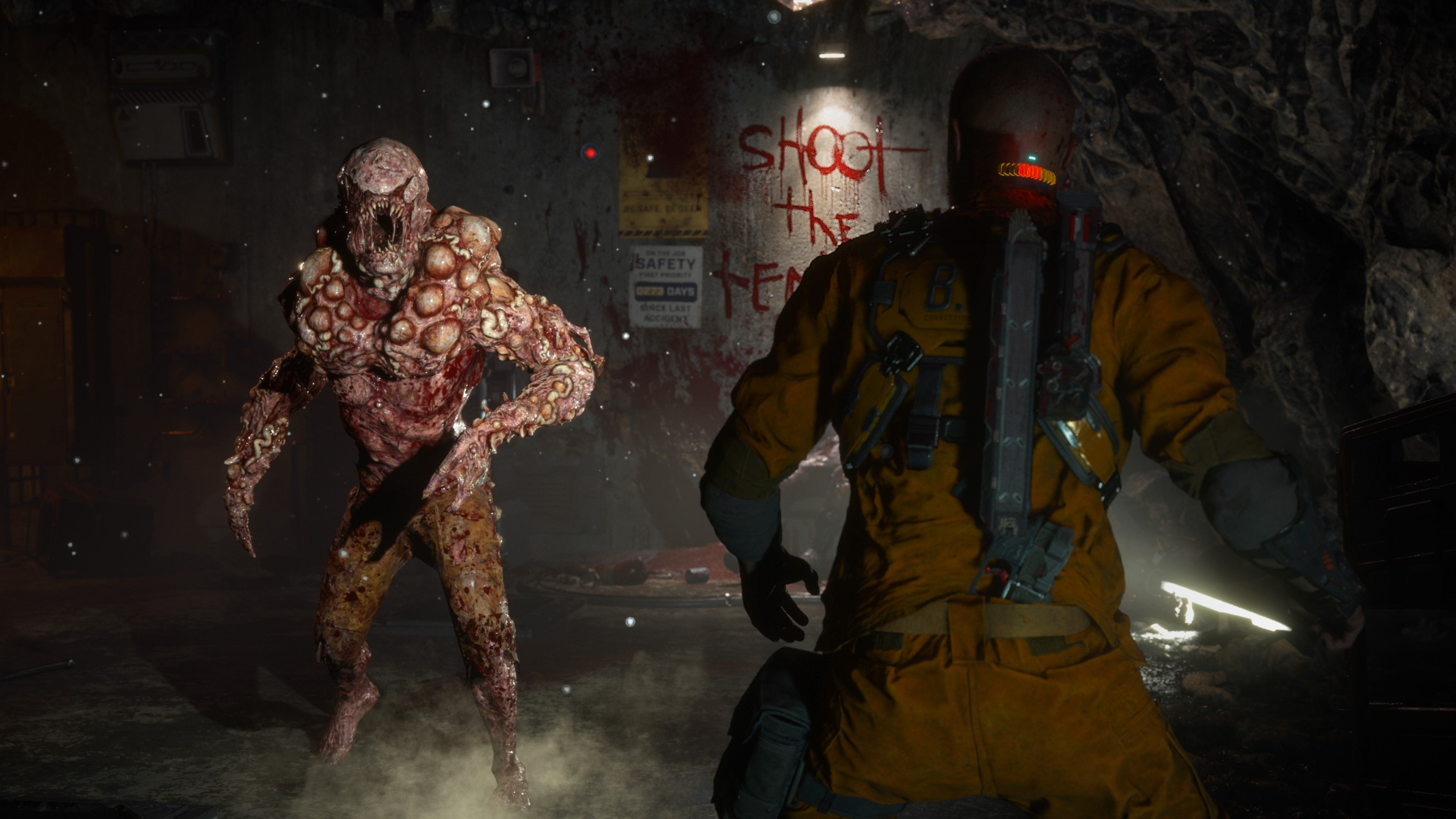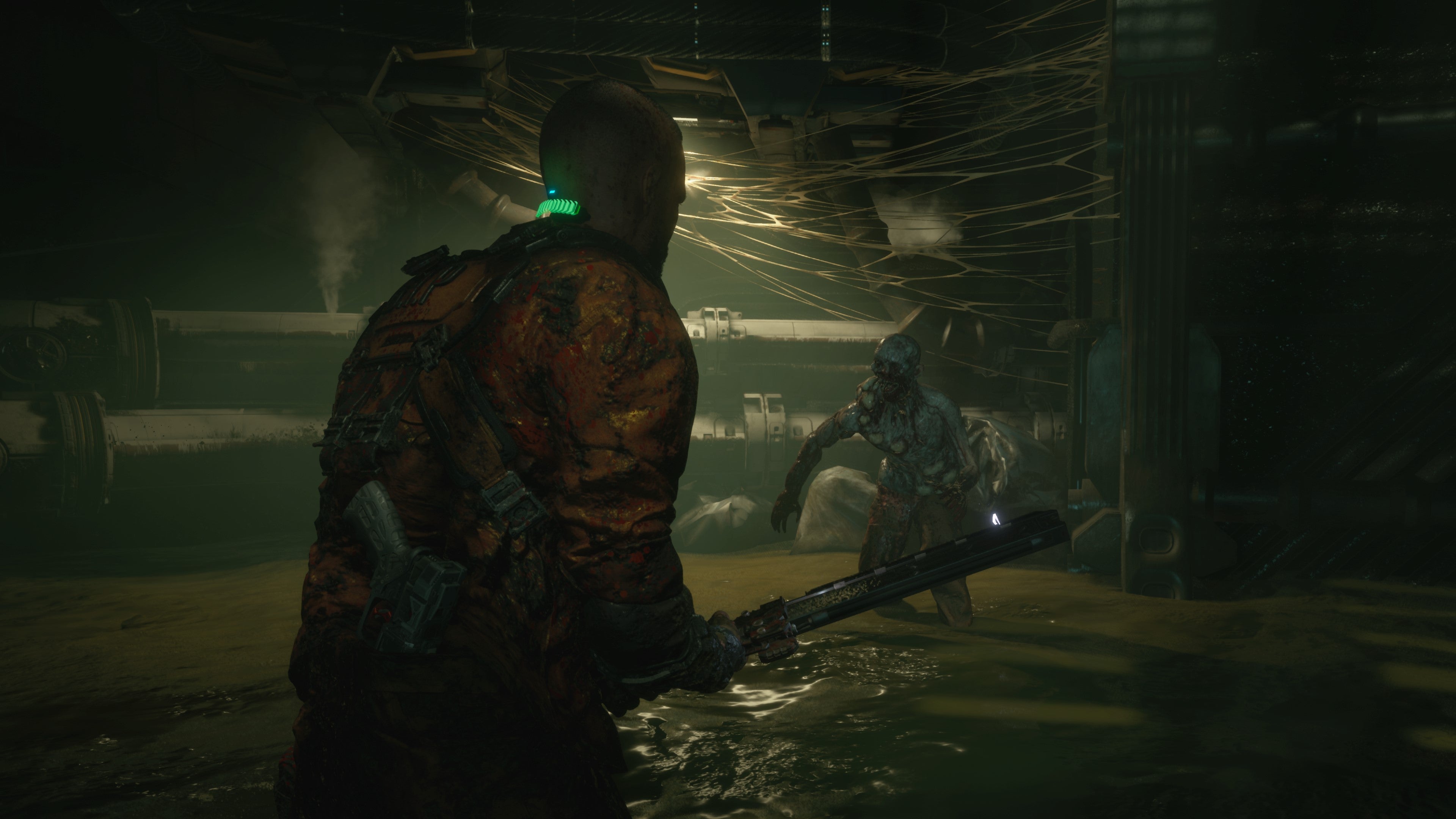If you asked me to summarise my entire demo experience with The Callisto Protocol in one word, I’d select “clunky”. If you asked me to sum it up in one vague action, I’d swing a Toblerone into a metal bollard and listen for the heavy snap as the dense mountains of chocolate snap in two. The game isn’t “clunky” in the sense that it’s difficult to control your character or sock a biophage (the game’s name for a zombie) in the dick, it’s more that everything is a heavy, weighty affair. The demo saw me explore a portion of the game – a good chunk of the way through the story already, I might add – where I clunked through dark corridors of a facility overcome with some form of bio-engineered parasite. If it wasn’t cold iron and fizzing wires, surfaces writhed with pustules and fleshy webs that encased former workers in a bloodied tangle. The sound and lighting effects expertly peppered what were largely dark environments with a sinister hue, illuminating flickering consoles in an eerie light or drawing my ear to the rustle of something in the vents above. But I wouldn’t say my time with the demo was all that scary, to be honest. I know fear is subjective in horror games, so your goosebumps may vary, but I rarely felt frightened and swayed more towards the tense. The path I followed was largely linear, with quite a few sections where I’d need to advance towards the objective by taking the one optional path ahead, flick a lever, then double back to where I’d started. I could see scares coming from a mile away, as I’d await the arrival of a baddy as I backtracked and know that they’d burst out of a vent or slither out of a nearby crevice. And the linear-ish path I followed seemed reminiscent of the types of games you’d get back in the day, like Gears Of War, or dare I say it – Dead Space. Not that this was a bad thing! I just tempered my expectations, which went from an unrestrictive, twisty-turny romp around a space facility, to a romp that still has twists and turns, but conforms to much more of a traditional, video-gamey structure. I know that’s a weird thing to say as, shock-horror - it’s a video game. But, having talked with the devs and sat through many presentations, it morphed in my head into a game of grand scope and scale. Where really, a lot of my time was spent ripping fuses from fuseboxes, then plugging them into clearly labelled boxes to open closed doors. Otherwise, I had to find and turn a specified number of red gears to open more doors. Again, I take no issue with Callisto’s linearity, as it felt like a proper curated ride of thrills and spills that landed at just the right times (plus, it saved me from getting lost). It’s impossible to tell if the entire game follows the fuses and red gears pattern, but I’d like to think it introduces new ways to explore or otherwise it risks becoming a touch samey. My time with Callisto shone in the combat sequences, which appeared just enough to keep me on my large metal toes. Again, this is where the heaviness of combat really kicked in, as I relied on a combination of three tools: my stun baton, my pistol, and my GRP (a magic fist that let me telekinetically lift enemies, then chuck them forwards). When presented with one enemy it’s almost a sickening delight, as you’re able to chop their legs off with the pistol to hinder their movement, then bludgeon them to a pulp with the baton. But when presented with a group (I’m unsure of the collective noun, suggestions on a postcard) of snarling biophage, the game’s combat is akin to a puzzle sequence as your moves, reloads, and swings all take time to complete. They’re challenging puzzles, too. The pistol deals damage, sure, but rattling several blasts into a baddie isn’t going to rattle them very much. Then you’ve got the baton, which is powerful but requires careful timing with dodges as you draw closer to enemies. So, success lies in marrying the two and working in the GRP. It’s the kind of combat that requires careful planning, and in a Resident Evil (or coughing Dead Space) sort of way, enemies shuffle towards you at just the right pace to create a sense of gradual panic. For example, there was one sequence that presented me with three enemies, one in riot gear, one who spat acid mucus at me, and one larger lad. I’d die to them often when swinging and spamming shots, but gradually I learned to pick them apart more methodically, stepping in for a baton swing, following up with a pistol shot for extra damage, before flinging the last one off a ledge as he lunged toward me. One time I was pinned in a corridor by another three lads, so used the GRP to toss a gas canister at them, which resulted in an explosion of bio-meat and licks of fire. And that’s a key pillar of Callisto, I think. All fights could be significantly shortened if I’d anticipated attacks and thought a little harder about how I could use the environment to my advantage. My time with The Callisto Protocol was brief, so it was tricky to get a strong sense of how the entire game will play out. But I was surprised at how old-school it felt, opting for a more linear approach to problems solved through collectible fuses. Throughout, though, I was fully engrossed in its lavishly produced facility, and I’m intrigued to see if the game expands a little more, or whether it sticks to the demo formula throughout.


